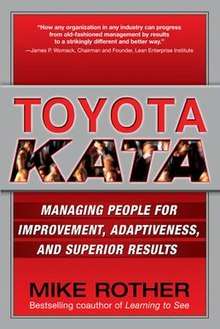Toyota Kata
Toyota Kata is a management book by Mike Rother. The book explains the Improvement Kata and Coaching Kata, which are a means for making the Continual improvement process as observed at the Toyota Production System teachable.[1]
 Front cover | |
| Author | Mike Rother |
|---|---|
| Country | United States |
| Language | English |
| Subject | Management |
| Publisher | McGraw-Hill |
Publication date | August 4, 2009 |
| Media type | Hardcover & eBook |
| Pages | 306 |
| ISBN | 978-0-07-163523-3 |
| OCLC | 459790467 |
| 658.3/01 22 | |
| LC Class | HD62.15 .R685 2010 |
Overview
Toyota Kata defines management as, “the systematic pursuit of desired conditions by utilizing human capabilities in a concerted way.”[2] Rother proposes that it is not solutions themselves that provide sustained competitive advantage and long-term survival, but the degree to which an organization has mastered an effective routine for developing fitting solutions again and again, along unpredictable paths. This requires teaching the skills behind the solution.[3]
In this management approach a primary job of leaders and managers is to develop people so that desired results can be achieved. They do this by having the organization members (leaders and managers included) deliberately practice a routine, or kata, that develops and channels their creative abilities. Kata are patterns that are practiced so they become second nature, and were originally movement sequences in martial arts.[2][4]
The Improvement Kata
The improvement kata is a routine for moving from the current situation to a new situation in a creative, directed, meaningful way. It is based on a four-part model:
- In consideration of a vision or direction...
- Grasp the current condition.
- Define the next target condition.
- Move toward that target condition iteratively, which uncovers obstacles that need to be worked on.
In contrast to approaches that attempt to predict the path and focus on implementation, the improvement kata builds on discovery that occurs along the way. Teams using the improvement kata learn as they strive to reach a target condition, and adapt based on what they are learning.[5]
Toyota Kata submits that the improvement-kata pattern of thinking and behavior is universal; applicable not only in business but in education, politics, daily living, etc.. The book's underlying message is that when people practice and learn a kata for how to proceed through unclear territory, they don't need to fear the obstacles, changes and unknowns they encounter. Rather than trying to hold on to a sense of certainty based on one's perspective, people can derive confidence from a kata for working through uncertainty.[6]
The notion of Improvement Kata as a process of continuous improvement contributed also to the formation of the DevOps movement. [7]
The Coaching Kata
The coaching kata is a routine used to teach the improvement kata and requires prior experience with practicing the improvement kata.[8]
References
- "Centre for Industrial services". University of Tennessee.
- Mike Rother (4 September 2009). Toyota Kata: Managing People for Improvement, Adaptiveness and Superior Results. McGraw Hill Professional. p. 15. ISBN 978-0-07-163985-9.
- "Toyota Kata course". ASQ.
- "Toyota Kata Engaged leadership". The Lean Thinker Blog.
- "Kata Habits". Systems2win.
- Mike Rother (4 September 2009). Toyota Kata: Managing People for Improvement, Adaptiveness and Superior Results. McGraw Hill Professional. p. 18. ISBN 978-0-07-163985-9.
- The DevOps Handbook: How to Create World-Class Agility, Reliability, and Security in Technology Organizations, Gene Kim, Patrick Debois, John Willis, Jezz Humble, 2016, p.6 and p.355
- Mike Rother (4 September 2009). Toyota Kata: Managing People for Improvement, Adaptiveness and Superior Results. McGraw Hill Professional. p. 171. ISBN 978-0-07-163985-9.
External links
- Dave Moran, Book review, Software Results, 23 September 2011
- Dirk Dusharme, A Kata for Developing Solutions – interview with Mike Rother, QualityDigest.com, 10 June 2010
- Kata Practitioner Days KPD, Open source recommendations for running a KPD – sample agendas and promotion ideas
- KataCon, Annual Gathering of Kata Proponents